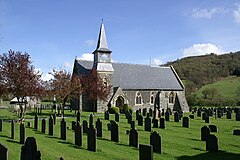
Summary
Carno is a village in Powys, Wales. The community, which is also a parish in the historic county of Montgomeryshire, comprises the townships of Derlwyn, Llysyn, and Trowscoed. It is in the geographical centre of Wales.[2]
| Carno | |
|---|---|
 Church of St John the Baptist, Carno | |
 Carno Location within Powys | |
| Population | 730 (2011)[1] |
| OS grid reference | SN961965 |
| Principal area | |
| Preserved county | |
| Country | Wales |
| Sovereign state | United Kingdom |
| Post town | Caersws |
| Postcode district | SY17 |
| Dialling code | 01686 |
| Police | Dyfed-Powys |
| Fire | Mid and West Wales |
| Ambulance | Welsh |
| UK Parliament | |
| Senedd Cymru – Welsh Parliament | |
Geography edit
The Afon Carno rises near the watershed with the Afon Dyfi; and runs 9 miles south-eastward to the River Severn, 2¼ miles north of Llandinam. The village's name is supposedly derived from the Welsh language word for cairn (carnedd), as there are many ancient cairns on the hills surrounding the village. The A470 road between Llanbrynmair and Caersws passes through the village. This part of the route follows the course of the Afon Carno through hilly country.[3] An electoral ward which includes the nearby village of Caersws had a population of 2,316 in 2011.
History edit
A Roman Fort named Gaer Noddfa is located next to the churchyard on the bank of the Afon Carno. The site encompasses a rectangular area 450 feet (140 m) by 270 feet (82 m).[4] A large mound occupies part of the fort; pottery found nearby indicate medieval usage but suggestions that it was a Norman fortification like a motte have been rejected.
In 952, Iago and Ieuaf, the two exiled sons of Idwal Foel, King of Gwynedd, invaded Dyfed. But they were defeated in a decisive battle near Carno by the sons of Hywel Dda, King of Deheubarth. The victory secured the sovereignty of North Wales.[5]
A Grade II* 16th century timber-framed house, Plasau Duon, is near the village.[6]
The Manor House Plas Llysyn was a property raided as an LSD factory as part of Operation Julie. Plas Llysyn was under surveillance and the well that supplied the house was destroyed to investigate the contents. £500,000,000 of LSD was manufactured in the cellars here, supplying 50% of the world's LSD at the time.[7][8]
Transport edit
Rail edit
The original Carno station was opened by the Newtown and Machynlleth Railway in 1863. It was closed, along with a number of stations on the Cambrian Line, as part of the Ministry of Transport's instigated Beeching cuts in the 1960s. In 2002 a campaign began to reopen a station near the village. In 2009 the Welsh Assembly agreed to examine the proposal as part of the Cambrian Rail Study.[9]
In 2014, the Welsh Assembly confirmed Arriva Trains Wales and Network Rail broadly agreed with an independent report recommending the reopening of a station at Carno.[10] However, a new station would need to be built as the original Victorian building (which was incorporated into the former Laura Ashley factory) is in private ownership.[11]
Notable people edit
- The designer and entrepreneur Laura Ashley (1925–1985) is buried in the churchyard.[12] Bernard and Laura Ashley moved from Kent to Carno in 1961. The company's original factory was in the village, adjoining the station building; it closed in 2005.[11]
- The parents of Chicago Outfit gangster Morris Llewellyn Humphreys, (Bryan Humphreys and Ann Wigley), emigrated to the United States from the village in the late 19th century. Dafydd Wigley is his third cousin.[13]
References edit
- ^ "Community population 2011". Retrieved 10 November 2015.
- ^ "The town at the centre of Britain". BBC News. 22 August 2014.
- ^ "Ordnance Survey map 128: Montgomery" (Map). One inch series. Ordnance Survey.
- ^ Wilson, D. R.; Wright, R. P. (1965). "Roman Britain (1964)". The Journal of Roman Studies. 55 (1/2): 199–228. doi:10.2307/297440. JSTOR 297440.]
- ^ Charles-Edwards, T.M. (2013). Wales and the Britons, 350-1064. OUP Oxford. p. 537. ISBN 978-0-19-821731-2.
- ^ "Plasau Duon, Caersws". British Listed Buildings. Retrieved 28 April 2016.
- ^ Hitt, Carolyn (27 March 2017). "The extraordinary story of the Welsh LSD ring that supplied the world". Wales Online.
- ^ Morris, Steven (29 June 2017). "Police patrol Welsh village to head off hunters of LSD stash". The Guardian.
- ^ "Campaign to reopen station gets a boost". Shropshire Star. 13 August 2009. Archived from the original on 21 August 2009. Retrieved 17 November 2009.
- ^ "Support to re-open Carno railway station". BBC News. 6 January 2016.
- ^ a b "Laura Ashley shuts 'home' factory". BBC. 25 October 2004. Retrieved 13 February 2008.
- ^ Laura Ashley burial place
- ^ Brookes, Geoff (2014). Welsh History: Strange but True. History Press. p. 187. ISBN 978-0-7509-5498-3.
External links edit
- Photos of Carno and surrounding area on geograph.org.uk
- Carno Station Action Group


